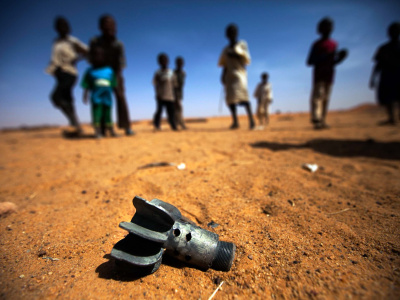
The missing link: African governance and peace architectures
Within the African Union (AU), strengthening governance is high on the agenda. On the 15th of February 2012 the African Charter on Democracy, Elections and Governance (the Charter) came into force. The adoption of the Charter was followed by the official launch of the African Governance Architecture (AGA) and its African Governance Platform (AGP), in May 2012, designed to increase coordination between the different institutions with a governance mandate and to create greater linkages between the AU instruments on shared values.
The increased emphasis on the importance of governance is not the end of the story. The link between governance and security is also becoming more significant. Illustrative of this, the AU's Peace and Security Council (PSC) and the Department of Political Affairs went on a retreat in September to discuss increased cooperation. And AU Peace and Security Commissioner Lamamra emphasised the importance of deepening democracy and improving political and economic governance in a speech he gave in January. Lamamra stated that durable peace, security and stability, as well as effective conflict prevention, needs improved political and economic governance.
Links between the AGA and APSA need to be strengthened - but how?
The launch of the AGP provides promising opportunities to create these stronger links with the APSA. The remaining question is: how? The AGA brings together a lot of actors and initiatives aimed at governance, but scores low on institutionalisation because the AGP remains an informal platform. The vision and ambition is there, but its lack of ability to follow-up the analysis of bad governance hinders its functionality.
One of the proposed initiatives to remedy this gap is connecting the AGA to the African Peace and Security Architecture (APSA). The APSA has already been operational for ten years and has a clear mandate for action as it is equipped with the PSC as its standing decision-making organ. However, it lacks a strong early warning mechanism that would allow it to pre-empt conflicts on the continent. The AGP can provide such support. This makes for an interesting partnership.
These two architectures already share some common ground. The PSC has the task to monitor the development of the member states towards democracy, good governance, law and order and the protection of human rights since these are identified as contributing factors for conflict prevention. The PSC also participates in the AGP. And both view the Charter as one of their building blocks.
Proposals for productive linkages
- The PSC will conduct an annual analysis on the progress of the democratisation process in the member states (Article 7(m) of the Protocol relating to the Establishment of the Peace and Security Council of the African Union). The AGA, as has been mentioned at the retreat,can deliver input for this analysis and the report which includes achievements, but also challenges. It is an opportunity for the AGA actors to put governance issues on the PSC agenda. The AGP could provide the PSC with the most important information improving the quality of the reports.
- A second proposal is the contribution of the AGA to the early warning system of the APSA. This would be by supporting the Continental Early Warning System (CEWS) and the Panel of the Wise (PoW) in their information gathering and the analysis of potential conflict situations. The CEWS and PoW have been designed to inform the PSC in a timely manner on potential conflict situations, allowing for the PSC to handle the situation before conflict breaks out. The AGA can inform the CEWS and the PoW on their findings on governance situations, which might contribute to the potential of conflict. The Department of Political Affairs has the responsibility for human rights, the emergence of democratic institutions, transparency and accountability, refugees, humanitarian crises and the monitoring of elections, which are all true early warning indicators.
- The AGA could bring non-compliance to the Charter to the attention of the PSC in cases where these breaches are potential threats to security.
- The AGA encompasses the provision of monitoring elections, executed by the Democracy and Electoral Assistance Unit. As there is a rise of electoral violence or outburst of conflict in connection to electoral outcomes, the AGA could inform the CEWS on the situation surrounding elections and the likelihood of conflict. The PSC can then act in accordance with its mandate – using their power of sanctioning or intervention.
- Organs of the AGA could also benefit from an exchange of information with the CEWS. For example, the reports made by the African Peer Review Mechanism (APRM), on the governance situations of the participating member states, could be exchanged with the CEWS as well as the PoW and the APRM might use information gathered by the CEWS.
The proposed links would not just strengthen the AGA, they would also improve the functioning of the APSA. The APSA was envisioned as a preventive structure, but so far its actions have been reactive. By establishing stronger early warning mechanisms, through the cooperation between the CEWS, the PoW and the AGA, the APSA would get more opportunities to act in a preventive manner.
Furthermore, the events of the Arab Spring have shown that the PSC was not equipped to analyse whether a given situation was a breach of the AU shared values - the normative ground for what counts as a legitimate political order are fundamentally contested. These terms could be clarified through timely discussion within the AGP. Especially the mix of the PSC, the Court on Human and Peoples’ Rights and the Regional Economic Communities would ensure the issues to be viewed from different sides.
Through the establishment of these linkages, the actors of the AGA can put their concerns on the agenda of the PSC (although maybe indirectly through the PoW and the CEWS), strengthening the AGA through the provision of possibilities for follow-up action. Importantly, these possible linkages could be implemented within the current framework of the AU. Linking the AGA to the APSA will contribute to the functioning of the AU with regard to the governance-security nexus. Using the already existing structures, but making them work together instead of separately, will benefit the already implemented structures and initiatives. --- Patty Claassens is an intern in ECDPM’s Africa’s Change Dynamics Programme This blog post features the author’s personal views and does not represent the view of ECDPM.

